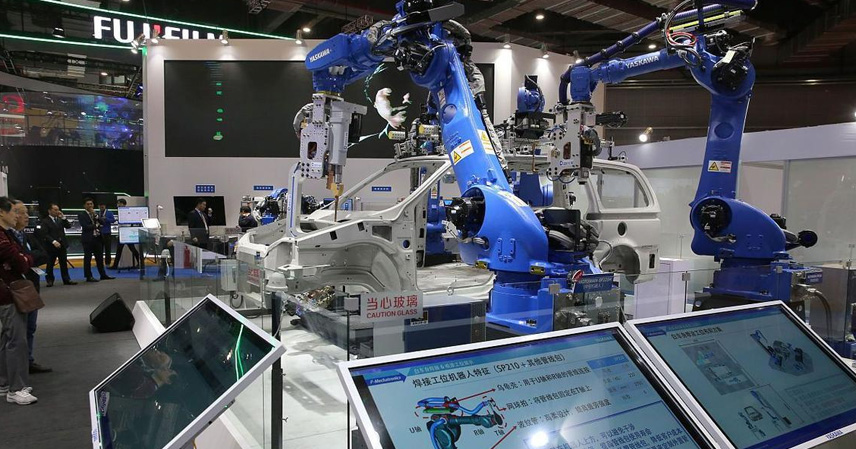In the first half of 2025, the global economy trudged forward through uncertainty. Within this storm—largely triggered by the United States’ unilateral trade actions—China and the U.S. delivered sharply contrasting “report cards.”
On one side, China’s goods exports managed a steady 7.2% growth (in RMB terms) despite mounting pressures. On the other, the U.S. saw its overall trade deficit surge by 38.3% year-on-year within just six months.
The divergence is not merely about percentages—it reveals deeper structural realities.
When President Donald Trump complained about America being “taken advantage of” and wielded tariffs to force manufacturing “reshoring,” he may not have foreseen that this gamble against economic principles would end up eroding the very foundations of America’s economic strength. What lies behind this reversal?
I. A Double Blow: Agriculture and Services Under Threat
For the U.S. in 2025, the word “deficit” has become its most glaring economic label.
Data shows that in the first half of the year, America’s goods and services trade deficit expanded by $161.5 billion compared with the same period last year. Ironically, the trade war—meant to protect domestic industries—has first wounded America’s two most competitive sectors.
The first casualty: agriculture.
For over half a century, agricultural exports were America’s proud surplus engine and even a strategic tool during the Cold War. Yet, in 2025, this legacy abruptly faltered.
According to the U.S. Department of Agriculture, the agricultural trade deficit soared to $28.6 billion in the first half—an all-time high. Why? China, the world’s largest importer of farm products, shifted more decisively toward Brazil and other suppliers. American farmers lost their most critical overseas market, and the U.S.’s long-standing dominance in global agriculture is steadily fading.
The second sector at risk: services.
While Trump focused obsessively on goods deficits, he neglected America’s real strength: services exports. From intellectual property to finance and digital technologies, the U.S. has held an unassailable global edge. Licensing fees alone bring in more than $144 billion annually.
But as tariffs multiplied, other countries found leverage to retaliate. EU President Ursula von der Leyen has already warned of extending trade measures to services, such as taxing U.S. tech giants’ digital ad revenues. Brazil’s Congress went further, passing an “Economic Reciprocity Act” enabling restrictions on U.S. services imports, including suspensions of IP rights.
As one U.S. economist remarked, sacrificing the nation’s strongest assets to shield a declining manufacturing base amounts to “a blatant disregard for basic economics.”
II. China’s “Three New Cards”: Resilience and Confidence
While the U.S. struggles in its own trap, China has displayed resilience—thanks to three new strategies quietly reshaping its trade posture.
1. New Buyers.
China’s exports no longer rely excessively on a single market. Take toys as an example: in 2006, the U.S. absorbed nearly 48% of China’s toy exports. By last year, that share had dropped to 26.5%.
Replacing it are booming emerging markets along the Belt and Road Initiative (BRI). In 2024, toy exports to Kyrgyzstan surged by 86.6% year-on-year. In the first quarter of 2025, China’s trade with BRI countries grew significantly faster than its overall trade—diversifying risks and redrawing its export map.
2. New Space.
China’s economy is a vast ocean, not a small pond. Its enormous and dynamic domestic market provides the depth to absorb external shocks.
In Q1 2025, retail sales of consumer goods hit 12.4 trillion RMB, a 4.6% year-on-year increase. Domestically, toy sales alone topped 97 billion RMB last year, growing 7.9%. This expanding internal demand offers a powerful buffer, turning “exports to domestic sales” into a stabilizing strategy.
3. New Momentum.
Rather than retreating under pressure, China is accelerating industrial upgrading—transforming “Made in China” into “Created in China.”
In the first half of 2025, high-tech product exports grew by 9.2%. High-end machine tools, ships, and marine engineering equipment each surged over 20%. Industrial robot exports soared 61.5%, pushing China to the world’s second-largest exporter in this field.
This move up the value chain—toward high-tech and high-value-added goods—is the true foundation of China’s resilience in global trade.
III. Beyond Numbers: A Contest of “Tactics” and “Strategy”
The two trade reports from early 2025 reflect not just numerical differences, but a clash of approaches.
The U.S. has chosen the path of “tactics”—tariffs, protectionism, and coercion. It tries to use hegemonic leverage to distort market rules and forcibly reshape global supply chains. The result? Disruptions across global markets, domestic shortages, panic buying, and deeper self-inflicted wounds.
China, by contrast, has chosen the path of “strategy”—focusing on its own development. Instead of sinking into zero-sum games, it is tapping the strength of its vast home market, cultivating diverse trade partners, and climbing toward technological self-reliance.
As China’s customs officials put it, the diversity of markets, the quality of innovative products, and the adaptability of trade players give China the “confidence and capacity to weather any risk.”
References
- “21.79 Trillion RMB! A Closer Look at China’s Trade Performance in H1 2025.” CNR, July 14, 2025.
- “U.S. Trade Deficit Shrinks 16% in June: What’s Behind It?” Yicai, Aug 6, 2025.
- “Deep Observation: Warnings Over America’s Most Profitable Export Sector.” CCTV News, Apr 15, 2025.
- “China Exports Over 3 Million Cars in Six Months, Overseas Plant Construction Accelerates.” China Economic Daily, Aug 18, 2025.
- “Food, Clothing, Shelter, Transport: America Changes by the Day, What Keeps China Steady?” People’s Daily, Apr 19, 2025.



